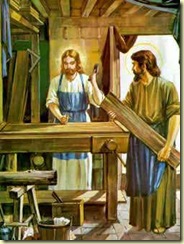My boss is a Jewish carpenter
 Think about the word carpenter. What does a carpenter do for a living?
Think about the word carpenter. What does a carpenter do for a living?
What type of carpenter was Jesus?
- A house-builder
- A furniture maker
- A chariot maker
- A brick mason
The word for carpenter in the gospels is τέκτων tekton. Our English work architect, meaning “chief builder” is related to this word.
The word occurs twice in the New Testament:
Matthew 13:55 “Isn't this the carpenter's son? Isn't his mother's name Mary? Aren't his brothers James, Joseph, Simon and Judas?”
Mark 6:3 “Isn't this the carpenter? Isn't this Mary's son? Isn't this the brother of James, Joseph, Judas and Simon? Aren't his sisters here with us?" They were not pleased with him at all.”
In these verse the people don’t seem to be complimenting Jesus. My assumption is that they considered Jesus to be an uneducated manual worker and unqualified for a teaching ministry.
Jesus was a blue-collar worker. “What does this construction worker think he’s doing?” That captures some of the condescension.
“Carpenter” is a slightly inaccurate translation. Do you agree?
I grew up in Oregon where entire houses are made of wood. They have studs for framing, plywood for underfloor, cabinets, siding and roofing all made of wood. So I grew up imagining Jesus wearing a toolbelt. Maybe with a couple of nails hanging from his lips. But houses were certainly not built that way in ancient times. Wood was scarce. Houses were made out of… what? I assume that the average house in Palestine was far closer in construction to an African hut than an American ranch-style house.
If you’ve only got a fuzzy notion of how houses were built in the time of Christ, you’re in good company. Luke might have been a good doctor but his knowledge of house construction in Galilee was rather weak. In the story of the paralytic let down through the roof, Mark precisely writes, “digging through it.” (2:4) Luke, no doubt imagining the houses of Rome with their tiled roofs writes, “through the tiles.” (5:19)
Can anyone share some online resources that talk about houses and carpenters in the time of Christ?
What kind of τέκτων do you think Jesus was?
See a couple of modern depictions of Jesus as a carpenter: embroidered, wood carving, bumper sticker
Update: Ben Witherington has a Jewish Carpenter poem with the “embroidered” image linked above: A CARPENTER'S CONFESSION.
Labels: Bible translation



8 Comments:
You're right in your assumption that our view of "carpenter" is a bit skewed to our context. Most of their structures would have been made out of stones or bricks. You can really think of Jesus as more of what we'd consider a stone mason.
Which reminds me of the 1990's controversy in the Southern Baptist Convention about whether membership in Masonic Lodges (and other secret societies) was allowed.
I had a seminary professor talk about this very issue of what it meant to be carpenter in ancient Palestine. After some discussion, he looked up from his notes, paused, and said, "Oh, but you can't ever say in your churches that Jesus was a mason."
Here's an early church reference that I snagged from Accordance:
"Καὶ ἐλθόντος τοῦ Ἰησοῦ ἐπὶ τὸν Ἰορδάνην, καὶ νομιζομένου Ἰωσὴφ τοῦ τέκτονος υἱοῦ ὑπάρχειν, καὶ ἀειδοῦς, ὡς αἱ Γραφαὶ ἐκήρυσσον, φαινομένου, καὶ τέκτονος νομιζομένου, (ταῦτα γὰρ τὰ τεκτονικὰ ἔργα εἰργάζετο ἐν ἀνθρώποις ὤν, ἄροτρα καὶ ζυγά, διὰ τούτων καὶ τὰ τῆς δικαιοσύνης σύμβολα διδάσκων, καὶ ἐνεργῆ βίον"
“And when Jesus came to the Jordan, He was considered to be the son of Joseph the carpenter; and He appeared without comeliness, as the Scriptures declared; and He was deemed a carpenter (for He was in the habit of working as a carpenter when among men, making ploughs and yokes; by which He taught the symbols of righteousness and an active life)”
(Justin Martyr, Dialogue with Trypho 88)
making ploughs and yokes
Yes. We tend to think of carpenters as people who build houses. But wouldn't a carpenter be a person who works/makes things with or out of wood? I never equate a carpenter with a stone mason. It's obvious that the yokes and the wooden parts of the plows had to have been made by someone who works with wood. I would imagine there were other items that were made of wood as well.
Looking up the Greek word TEKTWN in the BAGD Greek-English Lexicon of the New Testament and Other Early Christian Literature reveals that the word was sufficiently ambiguous to include carpenters (wood workers) and builders who worked with stone.
In Josephus Antiquities 15, 390, he relates "but got ready a thousand wagons, that were to bring stones for the building, and chose out ten thousand of the most skillful workmen, and bought a thousand sacerdotal garments for as many of the priests, and had some of them taught the arts of stone cutters, and others of carpenters, and then began to build; but this not till everything was well prepared for the work."
The interesting thing about the word TEKTWN here in Josephus is that it's talking only about stone. The TEKTWN here don't have to be in a stone-wood contrasting relationship. Perhaps it is the TEKTWN that build that lay the stones after the stone cutters have cut them.
Also, Aelis Aristides (2d. century A.D.) refers to a TEKTWN working with stone.
Archaeological digs around Nazareth reveal quite significant limestone quarrying. The rebuilding of Sepphoris, the capital city of Galilee, during Jesus' boyhood would have provided good work for a TEKTWN who only lived 4 miles away in Nazareth. See http://www.centuryone.org/sepphoris.html
and
http://www.uhl.ac/dig.html
I first started thinking about this matter a few years back after watching a video about Jesus from a more "liberal" slant, I guess we'd call it. Then I saw something from, I believe, BWIII. I did some leg work on it and have been calling Jesus a mason for the past couple years.
How about that for a famous book title: "More Than a Mason"
The idea of Jesus being a person who lays stones to make a building reminds me of 1 Peter 2:4-5, where we are asked to come to Jesus and be laid like stones to make a spiritual building. Perhaps Peter was alluding here to his master's trade.
Some of the earliest Greek we have seems to distinguish wood workers and stone workers.
Here is Thucydides's "History of the Peloponnesian War" (Book 5 chapter 82 section 6):
ξυνῄδεσαν δὲ τὸν τειχισμὸν καὶ τῶν ἐν Πελοποννήσῳ τινὲς πόλεων. καὶ οἱ μὲν Ἀργεῖοι πανδημεί, καὶ αὐτοὶ καὶ γυναῖκες καὶ οἰκέται, ἐτείχιζον· καὶ ἐκ τῶνἈθηνῶν αὐτοῖς ἦλθον τέκτονες καὶ λιθουργοί. καὶ τὸ θέρος ἐτελεύτα.
Some of the cities in Peloponnese were also privy to the building of these walls; and the Argives with all their people, women and slaves not excepted, addressed themselves to the work, while carpenters and masons came to them from Athens.
Funny stuff even earlier in Homer's Iliad (Book IV, 109-111), which just goes to show how versatile the skills of the "carpenter" were:
τοῦ κέρα ἐκ κεφαλῆς ἑκκαιδεκάδωρα πεφύκει: καὶ τὰ μὲν ἀσκήσας κεραοξόος ἤραρε τέκτων, πᾶν δ' εὖ λειήνας χρυσέην ἐπέθηκε κορώνην.
The horns that grew from the goat's head were sixteen palms' length. A carpenter working on the horn then bound them together, smoothing them to a fair surface, and put on a golden string hook.
And there's this early curiosity from Hesiod's Work and Days (24-26):
ἀγαθὴ δ' Ἔρις ἥδε βροτοῖσιν. καὶ κεραμεὺς κεραμεῖ κοτέει καὶ τέκτονι τέκτων, καὶ πτωχὸς πτωχῷ φθονέει καὶ ἀοιδὸς ἀοιδῷ.
and therefore this Discord benefits mankind. Every potter begrudges a potter, and a carpenter a carpenter; likewise, a poor man envies a poor man, and a singer a singer.
Thanks for that, JK. I'd have to see more examples to be able to come to any definitive conclusions. This could be a general-specific distinction i.e. builder-mason. I'm still unsure how to gloss this although for lack of better information I would probably favor "builder."
Post a Comment
Subscribe to Post Comments [Atom]
<< Home